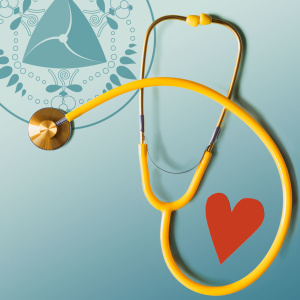Immunity, Your GPS for Health
This time of year there is a lot of talk of boosting immunity. On the heels of holiday stress and indulgences, with cold weather outside the door, we start to turn our attention to healthy pursuits in hopes of staying healthy through the rest of winter. In order to accomplish this, we take a myriad of vitamins, herbs, supplements. Or we exercise and go on restrictive diets. While many of these methods may work, it can be helpful to understand what the immune system is and how it works so, we can better identify what it is that we are doing that is working and what may be overkill.
The immune system is a complex combination of many cells and systems working in harmony with one another. Because the immune system has so many players, I am going to use an analogy to help my explanation of the system as a whole.
The immune system is pervasive and it relies heavily on an ability to be mobile and to find its way into any area of the body. Thereby its function is based on or at least closely related to the cells and molecules that flow through the channels and fluids in the spaces between those channels in the body. A simplified look at the immune cells distinguishes them as two types:
- Neighborhood Watch – These are cells or molecules whose predominant action is to identify invaders and call in additional help. These include T-cells, Helper T cells, B-Cells, and cytokines.
- Military/police cells – These are the cells or molecules whose job it is to target and neutralize invaders. They include Killer T cells, antibodies, macrophages, natural killer cells, and others.
As stated earlier, all of these cells and many others are found in the blood stream. Many other immune cells or molecules are also found in the lymphatic vessels, which have a close connection to the interstitial spaces. The blood vessels including the arteries and veins are considered to be the Highways of the body, because that is where most macro and micro molecules and cells are transported.
The immune system protects us form invaders and these foreign objects come into the body the same way that nourishing substances arrive. One of the primary ways that invaders are able to get into our body is through the digestive process. When we eat, the stomach and intestines break down the food into manageable parts. It does this by separating the consumed macro and micro molecules that the body can reconfigure to fit the specific needs of the organism. If however this process is incomplete or the system is overwhelmed, these parts are not efficiently broken down and they cannot be used by the body. In Ayurveda we call this Ama. Ama is anything that is undigested. This can include emotions, but for now I will focus on digestion as it relates to our food.
These larger unusable pieces are absorbed into the circulation. As they merge onto the highways of our body, they encounter traffic. They are like large semi’s grumbling down the road. If the highways are not too busy, they can make good time and get to a processing plant – i.e liver, lymph node, spleen – where they can be broken down into smaller parts and can be utilized by the body. When our digestion is consistently compromised, there starts to be too much traffic on the road and these semi’s get stuck and start to slow down the flow of circulation to various tissues and organs. These varied processing plants act like weigh stations. When the undigested food arrives, the attendants on duty have to check all the cargo which continues to slow down the flow of fluids carrying vital nutrients throughout the body. In other words, the flow of nutrient rich fluids that carry the immune system cells is severely compromised and the body is not able to mount an effective attack to invaders – all because of our last meal was not taken under ideal circumstances for optimal digestion.
As was mentioned before, some immune cells are like police. Even if the immune cells turn on their sirens to speed down the highway, their response time is significantly slower because as one highway becomes congested, all the surrounding roads do to. This brings us to the next aspect of the immune system, the lymphatic vessels. The lymphatic vessels are where the plasma and immune cells, like white bloods cells, hang out. The lymphatic vessels are like the back roads of the body. White blood cells are one of the primary components of the immune systems and the lymphatic’s can be thought of as seedy neighborhoods where crime often takes place. The largest amount of lymphatic tissue in the body is the gut associated lymphatic tissue (GALT) that is found surrounding the intestines. Like any police force, the body only has so many resources to dedicate to this crime fighting operation. If the body is consistently exposed to more undigested material than it can handle, the lymphatic tissue becomes stagnant and the criminals get stuck in swat cars and never make it to the police station, giving them the potential to break out and cause damage to other tissues in the body. I know that this analogy is not perfect, but this is one way to see the connection between the immune system and the digestive system.
So what can we do to improve immune function under these circumstances?
The concept of boosting the immune system does not make scientific sense. The cellular components of the immune system span many different systems in the body including the circulatory, digestive, and endocrine systems. Boosting the number of immune cells is not necessarily a good thing, unless the body is experiencing an infection or invasion of some sort. And which cells do you boost, there are so many kinds of immune cells that there is no way to objectively determine if increasing the number of immune cells will have the desired effect of promoting a speedy recovery and long term health.
Although it is not clear if more is better in terms of immune cells such as T cells, there is a clear threshold of cells that, when we have less than this, does not allow our immune system to mount an effective response. Instead of looking at ways to boost the cellular components of the immune system, Ayurveda looks to improving the responsiveness of the immune system, and this responsiveness can be easily augmented by improved digestion. Ayurveda has long been practiced as a preventative science that focuses on optimal digestion. By fully digesting our food, we do not leave the immune system open to compromise. If you are interested in learning some practical tips for improving digestion, join me at Hidden Springs Wellness Center on Jan 10th at 6:45.
Available: Private Ayurveda Sessions
-
 Ayurveda Session$250.00
Ayurveda Session$250.00




